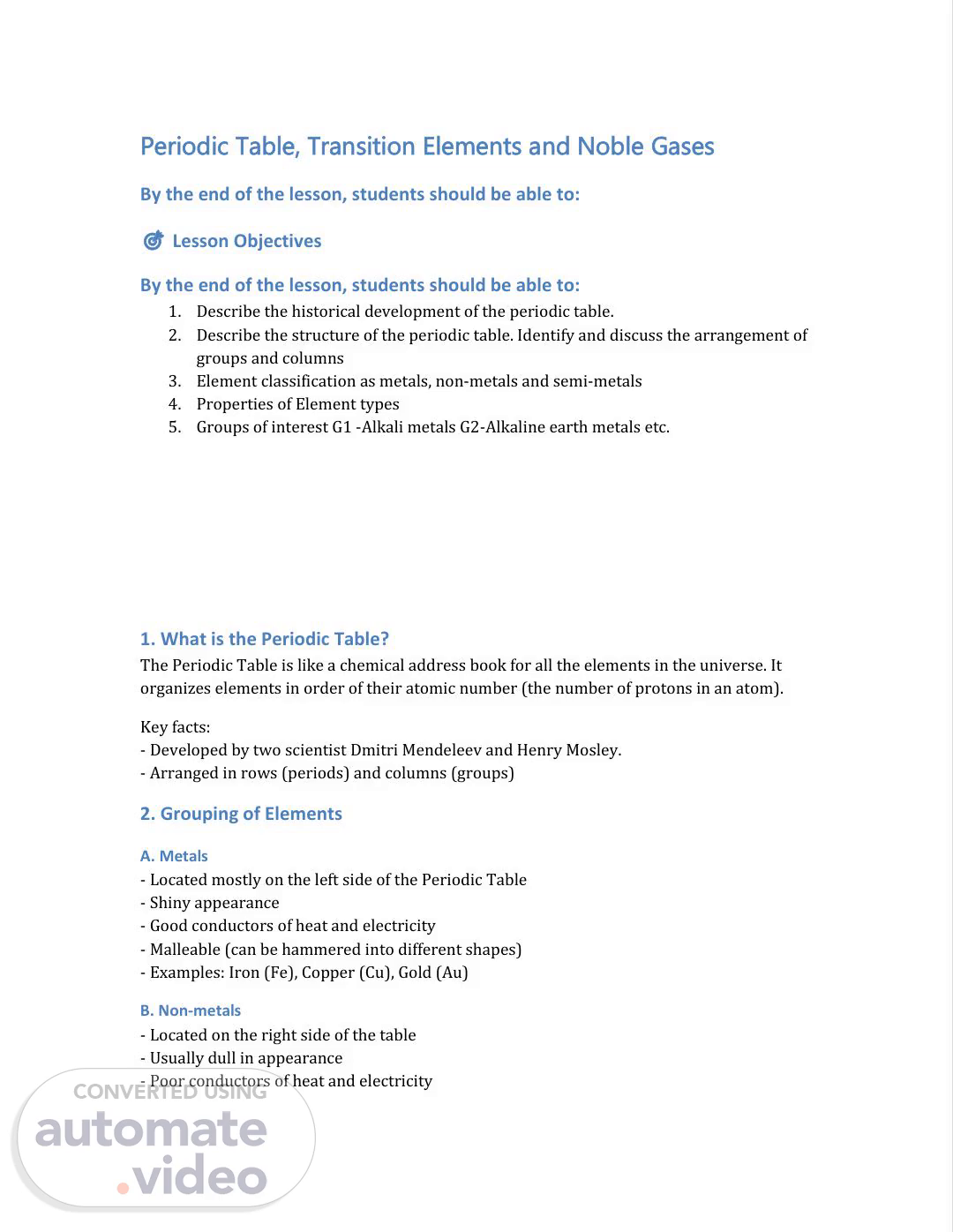Scene 1 (0s)
[Virtual Presenter] Periodic Table, Transition Elements and Noble Gases By the end of the lesson, students should be able to: Lesson Objectives By the end of the lesson, students should be able to: 1. Describe the historical development of the periodic table. 2. Describe the structure of the periodic table. Identify and discuss the arrangement of groups and columns 3. Element classification as metals, non-metals and semi-metals 4. Properties of Element types 5. Groups of interest G1 -Alkali metals G2-Alkaline earth metals etc. 1. What is the Periodic Table? The Periodic Table is like a chemical address book for all the elements in the universe. It organizes elements in order of their atomic number (the number of protons in an atom). Key facts: - Developed by two scientist Dmitri Mendeleev and Henry Mosley. - Arranged in rows (periods) and columns (groups) 2. Grouping of Elements A. Metals - Located mostly on the left side of the Periodic Table - Shiny appearance - Good conductors of heat and electricity - Malleable (can be hammered into different shapes) - Examples: Iron (Fe), Copper (Cu), Gold (Au) B. Non-metals - Located on the right side of the table - Usually dull in appearance - Poor conductors of heat and electricity.
Scene 2 (1m 33s)
[Audio] - Brittle (break easily) - Examples: Oxygen (O), Carbon (C), Sulfur (S) C. Semi-metals (Metalloids) Also known as metalloids, these elements have properties of both metals and non-metals. They are found along the "zig-zag" line between metals and non-metals on the Periodic Table. Characteristics of Semi-metals: - Appearance: Often shiny like metals - Conductivity: Semiconductors – better than non-metals, not as good as metals - Strength: Brittle, but stronger than some non-metals Example: Silicon (Si) – used in computer chips Fun fact: Mercury (Hg) is a liquid metal at room temperature! 3. Elements, Compounds, and Mixtures What is an Element? An element is a pure substance made of only one type of atom. It cannot be broken down into simpler substances by chemical means. Examples: Oxygen (O), Iron (Fe), Gold (Au) What is a Compound? A compound is a substance made of two or more elements that are chemically combined in fixed proportions. Compounds have different properties from the elements they are made from. Examples: - Water (H₂O) – made from hydrogen and oxygen - Sodium chloride (NaCl) – table salt What is a Mixture? A mixture is made by physically combining two or more substances. The substances in a mixture are not chemically joined and can be easily separated. Examples: - Air (a mixture of gases) - Salt water - Sand and iron filings Recap / Summary - The Periodic Table organizes elements by their atomic number - Elements are grouped as metals, non-metals, and semi-metals - An element contains one type of atom.
Scene 3 (3m 26s)
[Audio] - A compound is made of two or more elements chemically joined - A mixture contains substances physically combined but not bonded Next Lesson Preview In our next lesson, we will explore physical and chemical changes and how substances behave when mixed or reacted..
